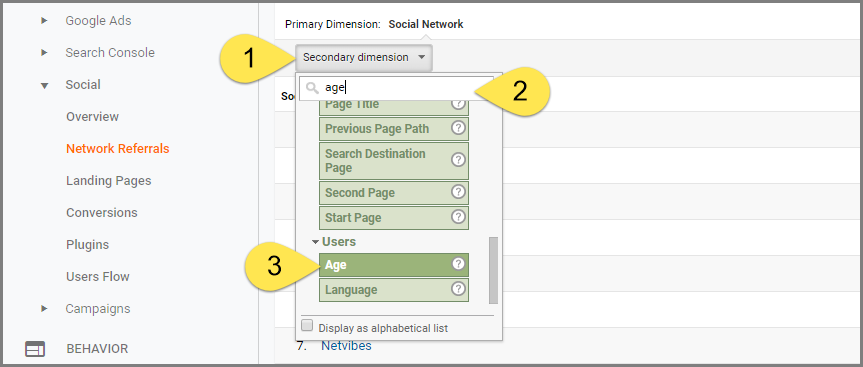Recently, my fellow ArtsHacker, Ceci Dadisman, and I conducted a private Google Analytics (GA) training session* for a nonprofit performing arts org. About mid-way through the session, we discovered that some of the attendees were unfamiliar with Secondary Dimensions and if there’s one GA feature that rises to “drop everything” status to learn, this is it.
Per Google’s geek-speak definition, the “Secondary Dimension feature allows you to define a primary dimension and then view that data by a secondary dimension within the same table.”
In English, that means you can cross tabulate data between two different dimensions; for example, look at traffic coming in from Facebook then break that down into age groups.

The good news is this is super easy to accomplish and requires zero customization work.
Most default GA reports provide the option of selecting a Secondary Dimension. You’ll know the option exists whenever you see the “Secondary Dimension” dropdown in the report toolbar:

In this example, we’ll add the age groups as a Secondary Dimension to the Network Referral Primary Dimension:

- Below the list of primary dimensions, select Secondary dimension.
- Browse the list of dimensions or enter all or part of the dimension name in the search box.
Tip: this is a typeahead field so go right ahead and start typing out the dimension name and that will cut down on your scrolling.
Tip: most of the secondary dimensions have a question mark icon next to their name, selecting that will clue you in on the type of data that dimension provides, - Select the dimension name you want to apply.
Removing a Secondary Dimension from the report is just as easy:

- Select the “x” icon to the right of the Secondary Dimension name in the header row.
There’s no right/wrong answer when it comes to selecting a Secondary Dimension. Instead, simply focus on developing a good habit of using them as frequently as possible. If you do, it won’t take long to figure our which combos provide the sweetest Google juice.
But if you really want a few to start off with, consider the following:
- (Primary Dimension: Acquisition>All Traffic>Channels) + (Secondary Dimension: Age) = which channels age groups use to find their way to your site.
- (Primary Dimension: Acquisition>Campaigns >All Campaigns) + (Secondary Dimension: Landing Page) = where visitors enter your site from your campaigns; this is especially useful if you have campaigns with more than one conversion URL.
- (Primary Dimension: Audience>Demographics>Age) + (Secondary Dimension: Device Category) = which device types, desktop, tablet, and Smartphone, are used most commonly among specific age groups.
- (Primary Dimension: Behavior>Site Content>All Pages) + (Secondary Dimension: Device Category) = determining if your most visited pages are visited using a desktop, tablet, or Smartphone device.
Which combos do you use and why?
*Feel free to reach out to either of us if you’re curious about scheduling a session for your organization.